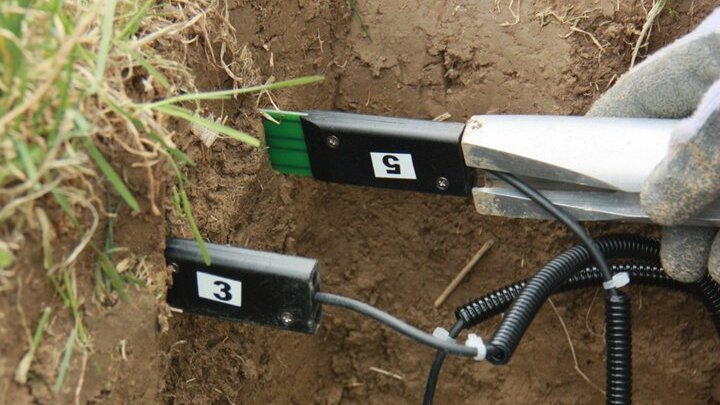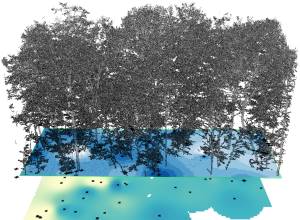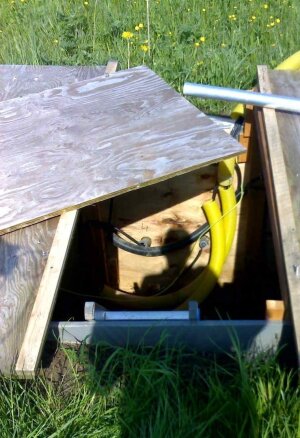
-
Canopy redistribution affecting subsurface hydrology
Due to interception, stemflow and canopy throughfall, precipitation reaches a forest soil surface in an altered temporal and spatial distri-bution. The retention of water by canopies is contrasted by the for-mation of dynamic hotspots. How do these processes impact soil water fluxes? Within the collabora-tive research center of AquaDiva, we assess precipitation, soil moisture and environmental properties in an extensive field study using a wire-less soil moisture sensor network. High temporal resolution soil water content data reveals flow dynamics and thus identifies preferential flow paths in the soil. Via geostatistical analysis, we will derive spatial distribution characteristics to relate net precipitation to subsurface (flow) patterns and identify their drivers.
Related publications
Fischer, C, JC Metzger, T Wutzler, G Demir, A Hildebrandt. 2023. Throughfall spatial patterns translate into spatial patterns of soil moisture dynamics – empirical evidence. Hydrology and Earth System Sciences 27, 2899-2023. https://doi.org/10.5194/hess-27-2899-2023External link
Metzger, JC, J Filipzik, B Michalzik, A Hildebrandt, A. 2021. Stemflow infiltration hotspots create soil microsites near tree stems in an unmanaged mixed beech forest. Frontiers in Forests and Global Change 4: 701294. doi: 10.3389/ffgc.2021.701293External link.
Metzger, J. C., N. Dalla Valle, T. Wutzler, J. Filipzik, R. Lehmann, M. Roggenbuck, D. Schelhorn, J. Weckmüller, K. Küsel, K. U. Totsche, S. Trumbore, A. Hildebrandt. 2017. Tracing spatial variation of canopy water fluxes to the soil with high resolution data. Hydrological Processes. doi:10.1002/hyp.11274External link.
Van Stan, J. T., Z. Norman, A. Meghoo, J. Friesen, A. Hildebrandt, J.-F. Coté, G. Moldanado. 2017. Edge to stem variability in wet canopy evaporation from an urban tree row. Boundary Layer Meteorology. doi:10.1007/s10546-017-0277-7External link.
Wollschläger U., D. Borchard, M. Brauns, M. Cuntz, P. Dietrich, J. H. Fleckenstein, K. Friese, J. Friesen, A. Hildebrandt, G. Jäckel, N. Kamjunke, K. Knöller, S. Kögler, R. Krieg, R. Kumar, A. Marx, R. Merz, C. Mueller, A. Musolff, H. Norf, M. Vieweg, C. Rebmann, F. Reinstorf, M. Rode, K. Rinke, L. Samaniego, H.-J. Vogel, M. Weitere, S. Zacharias, M. Zink. 2017. The Bode Catchment as part of the TERENO Harz/Central German Lowland Observatory: A platform for integrated, interdisciplinary hydrological research. Environmental Earth Sciences 76(1): Art. 29. doi:10.1007/s12665-016-6327-5External link.
Zimmermann, A., S. Voss, J. C. Metzger, A. Hildebrandt, B. Zimmermann. 2016. Capturing heterogeneity: The role of a study area's extent for estimating mean throughfall. Journal of Hydrology 542:781-789. doi:10.1016/j.jhydrol.2016.09.047External link.
-
Soil properties affected by vegetation patterns
Soil water plays a crucial role for biogeochemical cycles, affecting both water availability for plants as well as soil microbial activity. Soil water dynamics and variation are affected by several often interrela-ted drivers such as purely abiotic ones like soil texture, biotic ones like vegetation properties (e.g. be-lowground and aboveground bio-mass) and mixed ones like soil structure (e.g. soil bulk density affected by soil organic carbon). Because of this heterogeneity, soil moisture varies strongly over time and space. In this branch of our re-search, we investigate the dominant factors controlling spatiotemporal patterns of soil water in grassland and forests in several collaborative projects (Jena ExperimentExternal link and Colla-borative Research Centre AquaDiva).
Related publications
Demir, G, B Michalzik, J Filipzik, JC Metzger and A Hildebrandt. 2022. Spatial variation of grassland canopy affects soil wetting patterns and preferential flow. Hydrological Processes. 36(12), e14760, doi: 10.1002/hyp.14760External link.
Fischer, C., S. Leimer, C. Roscher, J. Ravenek, H. de Kroon, Y. Kreutziger, J. Baade, H. Beßler, N. Eisenhauer, A. Weigelt, L. Mommer, M. Lange, G. Gleixner, W. Wilcke, B. Schröder, A. Hildebrandt. 2019. Plant species richness and functional groups have different effects on soil water content in a decade-long grassland experiment. Journal of Ecology. doi:10.1111/1365-2745.13046External link.
Metzger, J. C., N. Dalla Valle, T. Wutzler, J. Filipzik, R. Lehmann, M. Roggenbuck, D. Schelhorn, J. Weckmüller, K. Küsel, K. U. Totsche, S. Trumbore, A. Hildebrandt. 2017. Tracing spatial variation of canopy water fluxes to the soil with high resolution data. Hydrological Processes. doi:10.1002/hyp.11274External link.
Fischer, C., J. Tischer, C. Roscher, N. Eisenhauer, J. M. Ravenek, G. Gleixner, S. Attinger, B. Jensen, H. de Kroon, L. Mommer, S. Scheu, A. Hildebrandt. 2015. Plant species diversity affects infiltration capacity in an experimental grassland through changes in soil properties. Plant and Soil 397(1):1-16. doi:10.1007/s11104-014-2373-5External link.
Fischer, C., C. Roscher, Jensen, N. Eisenhauer, J. Baade, S. Attinger, S. Scheu, W. W. Weisser, A. Hildebrandt. 2014. How do earthworm, soil texture and plant composition affect infiltration in managed grasslands along a plant diversity gradient? PLoS ONE 9(6): e98987. doi:10.1371/journal.pone.0098987External link.
-
Assessing the patterns of root water uptake
Little is known on how root water uptake profiles are shaped in diffe-rent vegetation communities, because no direct relation between root length density profiles and root water uptake profiles exists. Root water uptake might adapt in short time scales to changing soil water conditions, and to some extent independently of root distribution. Thus, although information about ecosystem root distribution is avai-lable, we know little about water-related ecological processes, like niche separation or facilitation. In our group we develop algorithms, which help interpret soil moisture measurements and derive dynamic root water uptake profiles. Our first application is on data collected along a diversity gradient at the Jena ExperimentExternal link. We also use detailed root architecture models to investigate hypotheses on how root interaction versus the hydraulic architecture shapes plant root water uptake. Applying thermo-dynamics we diagnose the impedi-ments to root water uptake at the plant scale.
Related publications
Guderle, M., D. Bachmann, A. Milcu, A. Gockele, M. Bechmann, C. Fischer, C. Roscher, D. Landais, O. Ravel, S. Devidal, J. Roy, A. Gessler, N. Buchmann, A. Hildebrandt. 2017. Dynamic niche partitioning in root water uptake facilitates efficient water use in more diverse plant communities. Functional Ecology. doi:10.1111/1365-2435.12948External link.
Hildebrandt, A., A. Kleidon and M. Bechmann. 2016. A thermodynamic fomulation of root water uptake. Hydrology and Earth System Sciences 20:3441-3454. doi:10.51947hess-20-3441-2016External link.
Guderle M. and Hildebrandt A. 2015. Using measured soil water contents to estimate evapotranspiration and root water uptake profiles - a comparative study. Hydrology and Earth System Sciences 19:409-425. doi:10.5194/hess-19-409-2015External link.
Bechmann, M., C. Schneider, A. Carminati, D. Vetterlein, S. Attinger, A. Hildebrandt. 2014. Parameterizing complex root water uptake models - the arrangement of root hydraulic properties within the root architecture affects dynamics and efficiency of root water uptake. Hydrology and Earth System Sciences 18:4189-4206. doi:10.5194/hess-18-4189-2014External link.


